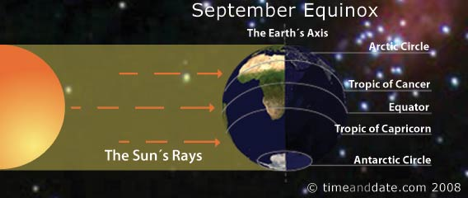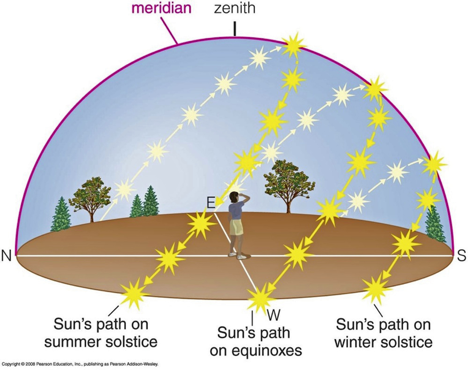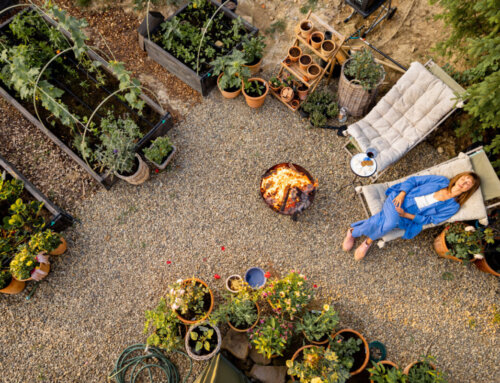by Elaine Johnson
“But now in September the garden has cooled, and with it my possessiveness. The sun warms my back instead of beating on my head … The harvest has dwindled, and I have grown apart from the intense midsummer relationship that brought it on.”
-Robert Finch
The seasons are governed by the tilt of the Earth’s axis in space as it journeys around the Sun in a year. When the South Pole of the Earth is tilted towards the Sun, this is our Winter. Six months later, when the South Pole is tilted away from the Sun, it's our Summer. In between these we have Autumn and Spring.
Temperatures on our planet are not determined by the distance of the Earth from the Sun. Rather it is the angle of the Sun’s rays striking the Earth. In Summer, the Sun is high in the Sky and the rays hit the Earth at a steep angle. In winter, the Sun is low in the Sky and the rays strike the Earth at a shallow angle.
The seasons don’t begin on one day and finish on another. That's because our orbit around the Sun is continuous. It actually takes quite some time for the Earth to heat up or cool down, and that’s why the seasons change gradually.
Note that everyone is not affected by seasons in the same manner or intensity. People can transcend seasons and feel what they want to feel about it. Shelley says, “If winter comes, can spring be far behind?
For some, winter covers their entire vision. They cannot foresee the tulips and daffodils sprouting, just a little later in the spring, when the ground is frozen in front of their eyes. Only a few people can recognize that winter is the mother of spring. Likewise, some enjoy the beautiful colors and crisp weather of the fall while for others, fall forebodes the arrival of the winter.
As the arrival of Fall approaches, this year on Sunday, the 22nd at 4:44 PM EDT, many of us bemoan the official end of Summer. Of course, our personal seasonal preferences vary, but there does exist a close relationship between the seasons and our moods. The ancients knew and recognized this and celebrated each season symbolically to reflect their awareness. In our fast paced modern culture many of us are too “disconnected” from Nature to observe the changes that occur in our bodies and minds.
For those of us who garden and observe the subtleties of the cycles of growth in plants we realize that Autumn is the time of harvest and gratitude. A time for reflection on the bountiful gifts Summer has provided and an opportunity to adjust our biological clock, slow down a bit and prepare for the restitution Winter will bring. A sweet sense of melancholy may be felt but on introspection we come to understand the nature of change and resolve to “live in the moment”. After all it is all any of us really have.
Spending time connecting with nature nourishes the soul, reminds you that you are never truly alone, and renews you by attuning you to the earth’s natural rhythms. Taking a walk under the stars or feeling the wind on your face may be all it takes for you to reconnect with nature. Remember, you are as much a part of nature as are the leaves on a tree or water bubbling in a brook. (Exerpted from Doug Green’s Blog; http://www.douggreensgarden.com/why-its-good-to-garden.html)
Plants make our lives bearable and that’s why you feel good when you garden. Observing the subtle changes that our plants undergo as we bid goodbye to the intensity of high Summer light and say hello to the reduced angle of the sun is part of the connection we feel to our gardens. I start to sense this shift in mid August as the days get a little shorter and the angle of the sun is now about 66 degrees from the horizon. Our plants also react to this shift and I notice that shade arrives earlier in the day to effect the blooming capacity of some of my annuals particularly in containers on my deck. Fortunately using plants with great foliage interest keeps them looking good. Some of the photos here show the heucheras which are favorites of mine available in a range of colors. I use them in borders and containers as well.
“Autumn Is A Second Spring, When Every Leaf Is A Flower” – Camus
Photo Credit: http://www.phillipoliver.net
About ELAINE JOHNSON
About the Author and Photographer: Elaine Johnson has been designing residential landscapes for over 20 years. She has a very strong background in creative design and project management for all phases of construction and installation. With an extensive knowledge of plant material suited to local growing conditions, she designs landscapes that have lasting beauty and integrity. To learn more about Elaine and see a portfolio of her work please visit her website at Elaine M. Johnson, Landscape Design.
We Are Supported By:





Join Our Community. Click here to learn more














